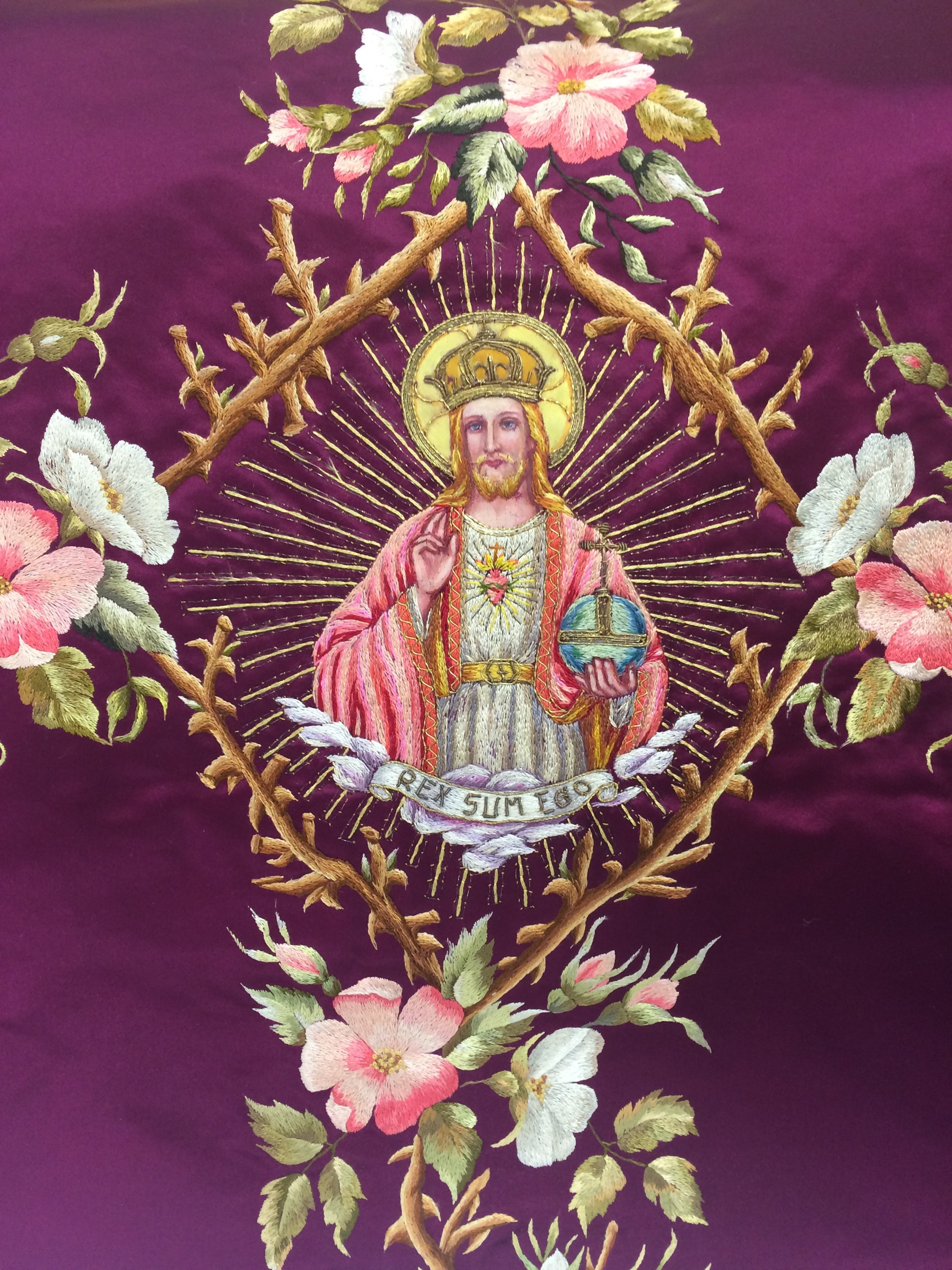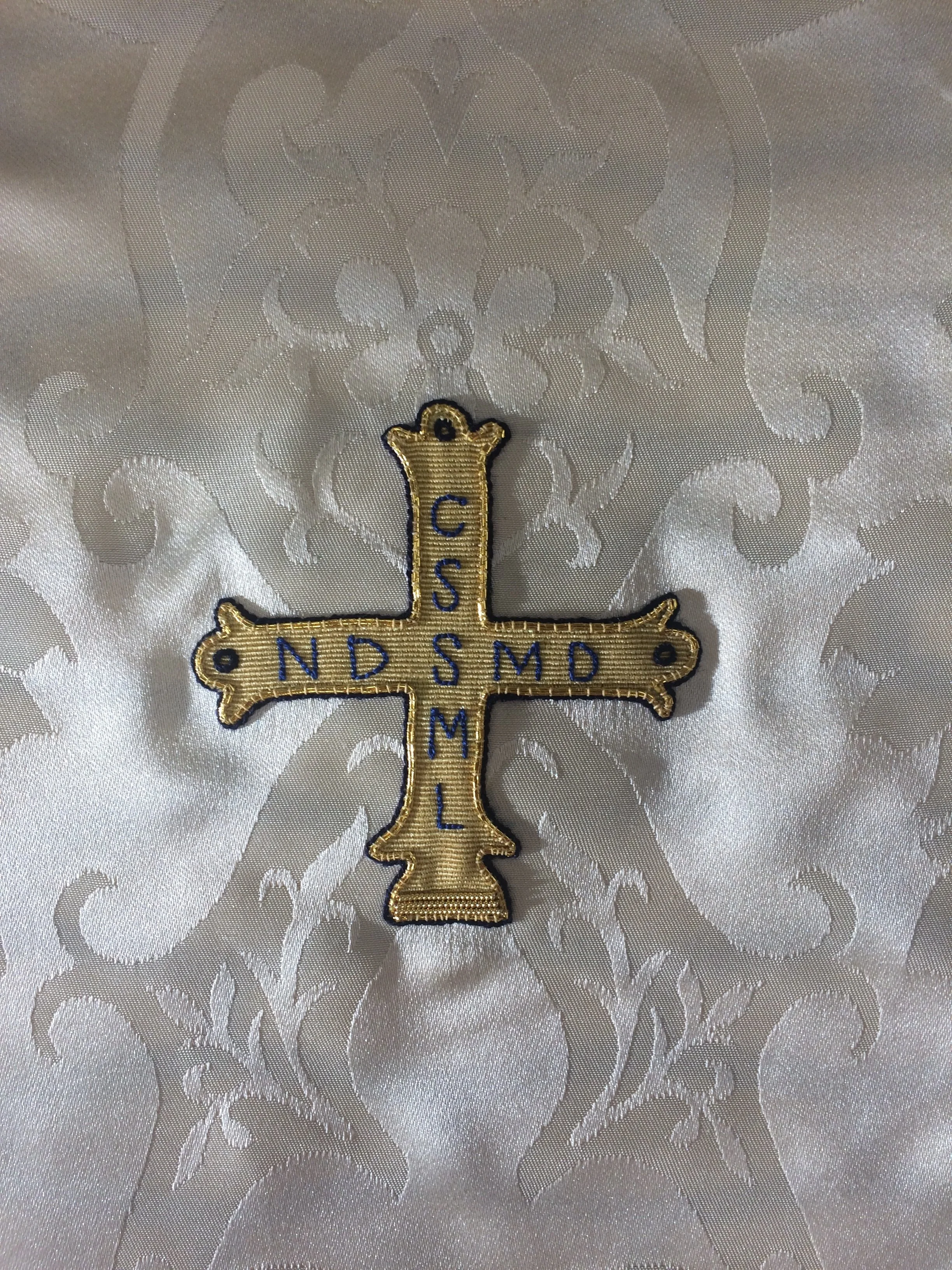Rex Sum Ego (“I am King”) – Advent/Lent Chasuble.
Bonchurch Pottery plaque for my Art Studio
I discovered Bonchurch Pottery as a child on holiday on the Isle of Wight with my grandparents. We used to take long coastal walks and arrive at the sea-front village, pottery shop and onsite studio.
My links with the IOW go back to when my great-aunt went to the island with her husband as newly-weds on their honeymoon. With a romantic free-spirit they decided never to come back and make Ventor their new home!
I am delighted to have a hand-made plaque for my studio by Andrew Bristow. Andrew’s style is instantly recognisable by the distinctive angled incise cut pattern, with horizontally brushed blue wash.
This was a Christmas gift organised by my auntie Christine.
Bonchurch is also associated with St. Boniface.
My Singer 128K sewing machine
I now have a second vintage handcrank Singer for my studio - this time a 128K and it’s in superb condition!
This particular model has rare “La Vencedora” decals (meaning “The Victrix” / female victor or champion). It was manufactured in November 1948 and produces neat, consistent stitches.
This one came with the original manual and I am currently researching the history of the different Singer models. The 128K included minor developments such as a vibrating shuttle, a high mounted bobbin winder and accessory compartment. There are also double slide plates. There is a beautiful grape vine and leaf engraving on the metalwork on the face plates (side and back).
The Singer for me represents engineering excellence, beauty and integrity. That is, they they were made to last! In the days before products were made with planned obsolescence.






Saint Benedict Medal
I have been working on an embroidered medal of Saint Benedict for Watts & Co. to be used either as part of a stole or altar frontal.
Saint Benedict is regarded a founder of Western Christian monasticism and lived in the 4th-5th centuries. The “Rule of Saint Benedict” contains the set of rules that his monks should follow.
Tradition holds that the medal protects from curses, evil and vice, protects against disease and protects good health. The medal is often included as part of a rosary or worn separately.
The front of the medal shows Saint Benedict holding a cross in his right hand and in the left his rule for monasteries.
The reverse side contains the following exorcism prayer. The first letters of which are inscribed on the cross and around the circumference of the medal.
In Latin it reads as:
Crux Sacra Sit Mihi Lux.
Non Draco Sit Mihi Dux.
Vade Retro, Satana!
Nunquam Suade Mihi Vana.
Sunt Mala Que Libas.
Ipse Venena Bibas.
This translates to English as:
May the Holy Cross be my light.
May not the dragon be my guide.
Begone, Satan.
Suggest not vain things to me.
Evil is the cup thou offerest.
Drink your own poison.
Here I have worked the reverse side of the medal on a damask background, using gold threads, purl-purl, applique and stranded cotton.
On the front side of the medal, to Benedict's right, below the cross, is a poisoned cup. This is a reference to the legend that hostile monks attempted to poison him, and the cup containing poisoned wine shattered when the saint made the sign of the cross over it. To his left, below the rule, there is the raven that carried off a loaf of poisoned bread. From this is derived the tradition that the medal protects against poisoning.
Royal School of Needlework Graduate Awards Ceremony
I was delighted to attend Hampton Court on 5th July 2021 to receive my Diploma in Technical Hand Embroidery from the RSN. I also received a ‘Special Mention Award’ for having achieved 93% in Blackwork for my Matador (see Gallery).
Click here for the RSN article:
https://royal-needlework.org.uk/graduate-awards-for-cd-and-future-tutors/
Watch the awards ceremony here:
https://www.instagram.com/tv/CQ8pk-_IpDk/?utm_source=ig_web_copy_link
Kenmare Lace
Kenmare Lace was introduced to Kenmare due to influences from French and Venetian laces and grew to prominence in Ireland and the world in the 1800s due to the support and skills of the Sisters of The Poor Clare’s Convent.
Here I have worked a sampler and flower motif designed by the Kenmare Lace and Design Centre in Co. Kerry, Ireland.
My sketchbook studies of The Spanish Masters
I have been studying the Masters of Spanish Painting based on a collection at the Museo del Prado in Madrid. Painters include, Murillo, Zurbarán, Velázquez, Rivera, Luis de Morales, Alonso Cano, El Greco, Claudio Coello, Pedro Berruguete, Pereda and Goya, to name a few.
Using various grades of lead pencil from 2B, to 4B and 6B (i.e. from hard to soft) gave me flexibility of movement and allowed me to model the forms with greater sensitivity. Using a rubber pencil I was able to obtain control of the light and shadows and gain a deeper understanding of the ‘chiaroscuro’ effects (that is shadows of light and dark cast on an object or person from an external light source).
I am aware that these paintings (using the chiaroscuro approach) employ a different philosophy to those used in icons, where the light comes from within. This is written or demonstrated by layers of colour built up from dark tones forming the under-painting, and lighter tones forming the top layers, eventually reaching white.
Overall, I noticed the images were very emotional and sentimental. Yet, very enchanting and sweet to behold.









Praying with the daffodils
Having recently completed the painting ‘St. Francis preaching to the birds’ (see Gallery), I was inspired taking a walk through my local park where I came across some daffodils.
It made me stop and think of the beautiful symbolism of prayer. They are all completely open and turned outward facing God the ‘Son’. They all stand straight and proud, in joy and happiness to be giving our Creator all the love and praise in perfect justice. The trumpet shape made me think of ears listening to the word of God and obeying His commands. Pray without ceasing.
Resurrexit! Sicuit dixit! Alleluia!
Our Lady and her great fruitfulness
I am thrilled to show the excellent work of a friend of mine who created this mixed technique piece of goldwork and silkshading. He said he was inspired on learning how the pomegranate was used to depict Our Lady and her great fruitfulness.
Guild of St Clare Vestment Mending Day (12th December)
The Guild of St Clare is happy to confirm that their vestment mending day on 12th December will go ahead as planned, at the church hall of St Gregory & St Augustine, Oxford. Click on the link for more information or to book a place.
http://www.guildofstclare.org/2020/11/vestment-mending-in-december.html






